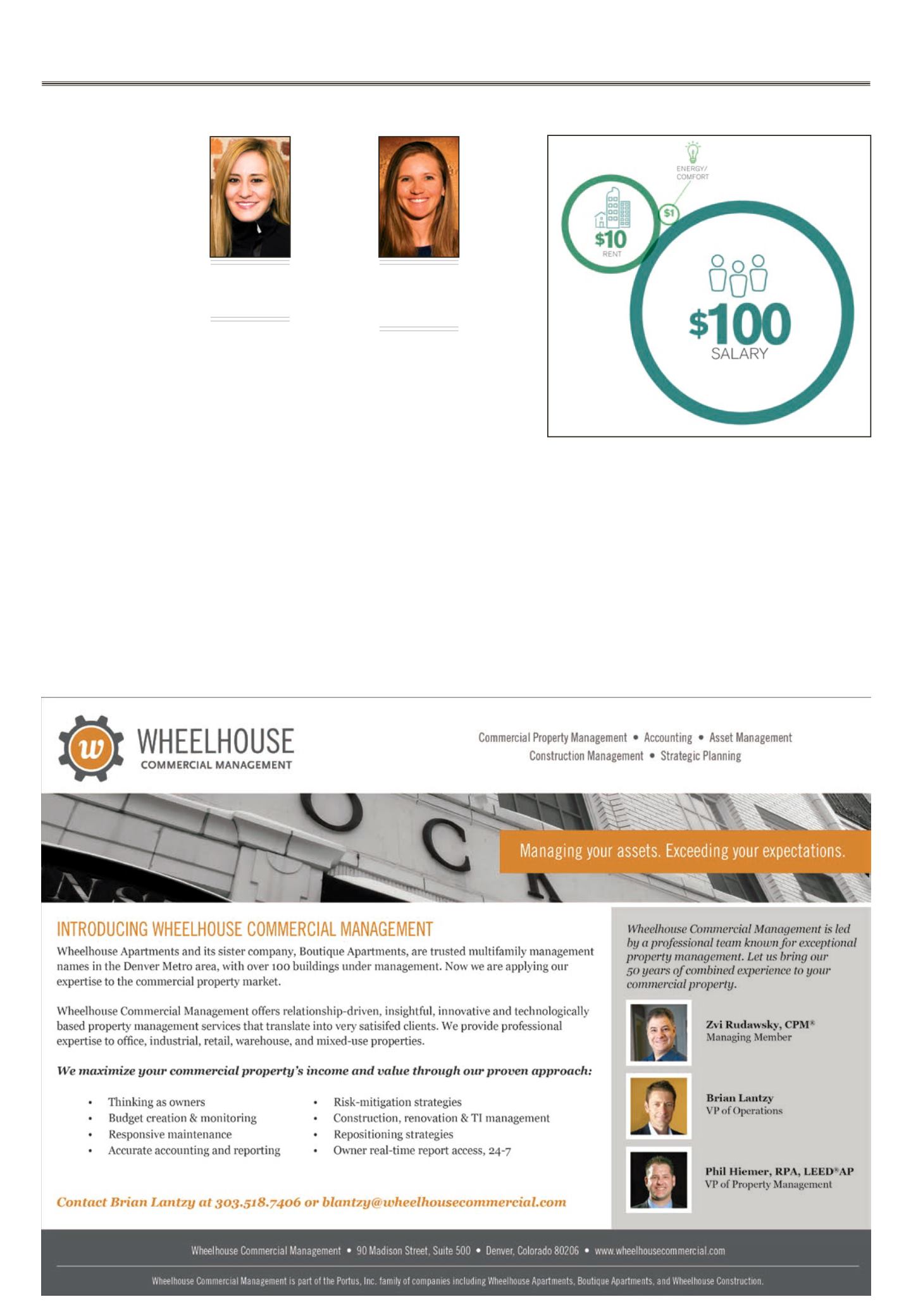
June 15-July 5, 2016 —
COLORADO REAL ESTATE JOURNAL
— Page 27
Construction, Design & Engineering
T
he building “tuneup”
process is being used
more and more by
building owners, operators and
developers as an investment in
human capital and a mechanism
for reducing operating costs.
It allows building owners and
operators to improve the effi-
ciency of what’s already in place
and address gaps in building
performance in both new and
existing buildings.
The
retro-commissioning
investment, or building “tuneup,”
typically pays back in less than a
year and can have a substantial
impact on the performance and
comfort of building occupants or
a company’s biggest resource –
its people.
According to the 1:10:100 rule,
for every $1 spent on energy,
$10 will be spent on rent and
$100 will be spent on employee
salaries. While energy conserva-
tion measures can save on util-
ity costs, “comfort” optimiza-
tion measures can provide even
greater savings in human capital
costs. Making the investment in
building performance and occu-
pant comfort is critical as physi-
cal environments account for 30
to 60 percent of variability in
worker performance.
Whether an existing building
was designed with high perfor-
mance in mind, an energy and
comfort audit can shed light on
critical issues and provide key
takeaways for getting a building
and its occupants operating at
peak performance.
Hord Coplan Macht recently
e n g a g e d
Group
14
Engineering
to perform an
energy and
comfort audit
on our LEED
P l a t i n u m
office build-
ing in Den-
ver – a 1922
former fire
station. While
d e s i g n e d
as a high-
performance
building during the 2009 reno-
vation, the audit identified sev-
eral areas to improve energy effi-
ciency, reduce utility expenses
and enhance employee health
and wellness through retro-
commissioning. The process pro-
vided some important lessons
for achieving high-performance
operation in our own build-
ing and those we design in the
future.
Here are five key takeaways.
n
The devil is in the details,
not the monthly utility bill.
Relying on a monthly utility
bill for a reference on building
performance can be misleading.
With real-time energy monitor-
ing and submetering in place,
it becomes much easier to iden-
tify performance or comfort
issues plaguing a building. At
our building, it was clear that
the overnight energy use was
high for the existing mechani-
cal equipment. By conducting an
occupant indoor environmental
quality survey, we were able to
pinpoint areas
needing to be
add r e s s e d ,
i n c l u d i n g
lighting, tem-
perature and
acoustics.
n
Don’t
take controls
c o m p l e x -
ity lightly.
To
achieve high-
e f f i c i e n c y
design, we
are more fre-
quently turn-
ing to highly
complex systems operated by
computerized controls. With-
out proper controls, even highly
efficient systems may be using
more energy than their low-cost
competitors. When planning
new systems, consider whether
a complex system is the most
appropriate or if it will be too
complex for users and will get
overridden. Remember, occu-
pant controllability has a large
bearing on satisfaction.
n
Remember the KISS prin-
ciple when it comes to light-
ing.
There are many times when
“keeping it short and simple”
is the best choice. While we
employed advanced lighting
controls in our building, the
lighting controls had issues we
were not aware of, making the
efficient lighting design consume
more energy than intended. LED
fixture options with built-in con-
trols are ever expanding and can
be a good option.
n
Small problems can add up
to big dollars.
Identifying small
issues in a building, such as a
pump stuck on, a chiller running
long hours or improper controls
can add up in energy use and
dollars, and it can help improve
the comfort and productivity of
occupants. As we implemented
even small changes in our build-
ing, employee comfort improved
and the overnight mechanical
meter energy was reduced over
60 percent, which is estimated to
reduce our energy costs 20 per-
cent. This savings will quickly
offset the sound masking system
installed to address acoustics in
our open office.
n
Gear your building up for
a smooth landing.
It’s common
for buildings to operate for an
entire decade with undetected
issues that can be easily resolved.
The soft landings process devel-
oped by BSRIA (owned by The
Building Services Research and
Information Association) can
help solve performance gaps by
early measurement and moni-
toring up to three years after
initial operation. Good design is
key, followed by ongoing moni-
toring so buildings can operate
as intended and have a positive
effect on the triple bottom line:
people, planet, profit.
s
Ara Massey
Senior associate/
sustainability director,
Hord Coplan Macht,
Denver
Celeste Cizik
Existing buildings
team leader/senior
energy engineer,
Group14 Engineering
Inc., Denver


